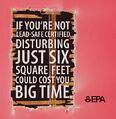Will Reinstating the RRP Opt Out Provision Really Help Your Business?
Recently Legislation introduced by Senator Inhofe (R) in Bill 2148, the ‘‘Lead Exposure Reduction Amendments Act of 2012’’, among other amendments within the bill, included reinstating the RRP opt out provision that was previously removed when the Sierra Club sued the EPA back in 2009. There is certainly some difference of opinion within the industry regarding whether reinstating the RRP opt out provision makes sense and or will actually be beneficial. A recent guest blog on RRPedia by Peter Lawton triggered comments from many in favor and against the opt out. One commenter admitted he was originally in favor of the opt out but was rethinking his position after reading Peter’s blog post.
So, will the opt out actually help businesses? Maybe. Maybe not...
 I suggest the real problem is that the original rule was poorly conceived and poorly written. Because we are now stuck with it, the proposed amendments are really just band-aid approaches to try to make it better for or more palatable to those affected by the rule. What we really need is a new well thought out rule to replace the existing rule, with the input and leadership of the industry this time. And, the industry needs to be proactive this time in its writing, its content and its enforcement.
I suggest the real problem is that the original rule was poorly conceived and poorly written. Because we are now stuck with it, the proposed amendments are really just band-aid approaches to try to make it better for or more palatable to those affected by the rule. What we really need is a new well thought out rule to replace the existing rule, with the input and leadership of the industry this time. And, the industry needs to be proactive this time in its writing, its content and its enforcement.
That said it is not likely that the rule will be abandoned and replaced by EPA. Doing so would be an embarrassment to EPA because it would essentially be admitting it had screwed up. So, we have to deal with trying to improve upon the existing rule.
Here are several considerations that need to be recognized if the Opt-Out becomes available again:
Not using lead safe practices on a pre 1978 property is a big risk. Unless the house is pretested before renovations there is no point of reference regarding existing contamination. If lead safe work practices are not used, how will the business prove it did not cause the contamination?
- If not following the RRP protocols and documenting work practices, the contractor will not be able to provide a preponderance of evidence in his/her favor if accused by the client and or their children of lead related problems after a renovation.
- If the contractor allows a client’s use of the opt out the business and the business owner will still be responsible and liable for damages if the work done by employee well as sub contractors contaminates the house during the work.
- If the home is pre 1978 and is not tested for lead, the contractor must still assume it has lead and must follow OSHA requirements to protect workers and sub contractors.
- Are your employees aware of the above point? What would they do and how will your business be affected if they do become aware and contact OSHA and/or have their blood checked for lead?

Not having to follow the RRP rule might just create more problems and risks than following it. The home owner can choose the opt out to avoid the extra cost. A contractor can also choose to opt out on the opt out. If you’re a renovator what will you do regarding the opt out and why?

 Looking for accurate information about the EPA RRP rule?
Looking for accurate information about the EPA RRP rule?  Legislation introduced by Senator Inhofe (R) will soon be before the US Senate for consideration. Inhofe introduced Bill 2148, the
Legislation introduced by Senator Inhofe (R) will soon be before the US Senate for consideration. Inhofe introduced Bill 2148, the  Unfortunately we are stuck with the RRP Rule. Maybe the best we can do is try to improve upon it.
Unfortunately we are stuck with the RRP Rule. Maybe the best we can do is try to improve upon it. This one requires EPA to actually use science to justify its position regarding any future RRP related regulations related to residential as well as commercial properties:
This one requires EPA to actually use science to justify its position regarding any future RRP related regulations related to residential as well as commercial properties: Anne points out that EPA Administrator Lisa was quoted to say “EPA is back on the job" and that EPA has received the largest enforcement budget in its history, making it more likely that your business will be subject to some type of investigation.
Anne points out that EPA Administrator Lisa was quoted to say “EPA is back on the job" and that EPA has received the largest enforcement budget in its history, making it more likely that your business will be subject to some type of investigation.  Although a written request for information should specify the statutory authority for the request, don't assume that the agency actually has the cited authority. Knowing the source of the government's authority for the request, as well as determining the applicability of the request to your business, is imperative in both limiting the scope of your response and protecting your business interests with customers and other parties that may be affected by the request.
Although a written request for information should specify the statutory authority for the request, don't assume that the agency actually has the cited authority. Knowing the source of the government's authority for the request, as well as determining the applicability of the request to your business, is imperative in both limiting the scope of your response and protecting your business interests with customers and other parties that may be affected by the request. Keep in mind that the rule requires that renovators keep all required documentation and that it be available for EPA audit for 3 years. That means EPA can retroactively enforce the rule 3 years back. If and when enforcement happens, all EPA needs to do is ask to see a renovators documentation to determine whether all the regulated work performed during that 3 year period was properly documented, met the rule’s requirements and that property owners and/or tenants received the required Renovate Right pamphlet, any lead testing results documentation as well as a copy of the required renovation checklist. Remember, the fine is up to $37,500 per violation per day!
Keep in mind that the rule requires that renovators keep all required documentation and that it be available for EPA audit for 3 years. That means EPA can retroactively enforce the rule 3 years back. If and when enforcement happens, all EPA needs to do is ask to see a renovators documentation to determine whether all the regulated work performed during that 3 year period was properly documented, met the rule’s requirements and that property owners and/or tenants received the required Renovate Right pamphlet, any lead testing results documentation as well as a copy of the required renovation checklist. Remember, the fine is up to $37,500 per violation per day! Plus, one fact that many business owners may not be aware of is that, under the rule, the business owner can be held civilly liable for violating the rule. Don’t assume you are personally protected just because of the legal status of your business.
Plus, one fact that many business owners may not be aware of is that, under the rule, the business owner can be held civilly liable for violating the rule. Don’t assume you are personally protected just because of the legal status of your business. From March through June 2011, a dedicated work group of NARI members regularly convened for the purpose of documenting challenges in the application of EPA's Lead Renovation, Repair and Painting Rule (LRRP Rule). NARI's purpose is to convey to the EPA what is working and what is not working in implementation and to make recommendations. The work group identified the following prioritized concerns with recommendations:
From March through June 2011, a dedicated work group of NARI members regularly convened for the purpose of documenting challenges in the application of EPA's Lead Renovation, Repair and Painting Rule (LRRP Rule). NARI's purpose is to convey to the EPA what is working and what is not working in implementation and to make recommendations. The work group identified the following prioritized concerns with recommendations: There has been a lot of confusion regarding the details of the EPA RRP rule. One that seems to pop up over and over is certification requirements for sub contractors. There are two different certification considerations regarding sub contractors; firm certification and worker certification. Let’s take a look at each separately.
There has been a lot of confusion regarding the details of the EPA RRP rule. One that seems to pop up over and over is certification requirements for sub contractors. There are two different certification considerations regarding sub contractors; firm certification and worker certification. Let’s take a look at each separately. Whether working for the general contractor as a trade partner or a 1099 sales person (offers the work), sub contractors must become certified firms by apply for certification through the EPA. Ensuring that the subs they use are certified firms is particularly important for general contractors, because as part of the required documentation under the rule, the renovation checklist must include the names of all workers who participated in RRP activities on the job. If a sub contractor and his workers do work on the job and the sub’s firm is not certified, the EPA will easily be able to find both the general contractor and the sub in violation of the rule. If a general contractor knows that subs must be certified firms, hiring a non-certified firm to work on a job becomes a knowing and willful violation of the rule, which brings with it serious penalties. It’s also one easy way for a customer’s lawyer to suggest the contractor is/was negligent.
Whether working for the general contractor as a trade partner or a 1099 sales person (offers the work), sub contractors must become certified firms by apply for certification through the EPA. Ensuring that the subs they use are certified firms is particularly important for general contractors, because as part of the required documentation under the rule, the renovation checklist must include the names of all workers who participated in RRP activities on the job. If a sub contractor and his workers do work on the job and the sub’s firm is not certified, the EPA will easily be able to find both the general contractor and the sub in violation of the rule. If a general contractor knows that subs must be certified firms, hiring a non-certified firm to work on a job becomes a knowing and willful violation of the rule, which brings with it serious penalties. It’s also one easy way for a customer’s lawyer to suggest the contractor is/was negligent. According to an
According to an  The following is News Release from EPA, published on February 8, 2011. Though not specific to the RRP Rule, this action by both EPA and the FBI shows that willfull violators of lead related regulations are currently a major focus for EPA and they are serious about prosecuting violators.
The following is News Release from EPA, published on February 8, 2011. Though not specific to the RRP Rule, this action by both EPA and the FBI shows that willfull violators of lead related regulations are currently a major focus for EPA and they are serious about prosecuting violators.  While deleading activities conducted in residences and child-occupied facilities often involve work methods similar to those typically used in renovation, repair or painting (RRP) activities, such as replacing windows, painting and installing vinyl siding, the two types of activities are distinct from each other in terms of purpose and effect.
While deleading activities conducted in residences and child-occupied facilities often involve work methods similar to those typically used in renovation, repair or painting (RRP) activities, such as replacing windows, painting and installing vinyl siding, the two types of activities are distinct from each other in terms of purpose and effect. Once you have made the initial determination regarding whether your project is a renovation project or a deleading project, the next question is how to choose a contractor who is licensed and qualified to perform the work. Click on the following link to view a helpful guide on choosing a deleading contractor, “
Once you have made the initial determination regarding whether your project is a renovation project or a deleading project, the next question is how to choose a contractor who is licensed and qualified to perform the work. Click on the following link to view a helpful guide on choosing a deleading contractor, “

 Renovators should be aware that in addition to EPA or administering states, other individuals or entities may likely take advantage of the documentation requirements to hold renovators accountable for their actions or lack thereof.
Renovators should be aware that in addition to EPA or administering states, other individuals or entities may likely take advantage of the documentation requirements to hold renovators accountable for their actions or lack thereof. OSHA could use RRP paperwork to prove non-compliance with its Lead in Construction Standards. OSHA’s worker protection requirements related to lead are very specific. Information contained in the required RRP documentation, particularly the renovation checklist and non-certified worker training documentation, could easily be used to show workers were not adequately trained and or protected when working in contained work areas. A lack of the required documentation could also be used by OSHA to demonstrate negligence by the business.
OSHA could use RRP paperwork to prove non-compliance with its Lead in Construction Standards. OSHA’s worker protection requirements related to lead are very specific. Information contained in the required RRP documentation, particularly the renovation checklist and non-certified worker training documentation, could easily be used to show workers were not adequately trained and or protected when working in contained work areas. A lack of the required documentation could also be used by OSHA to demonstrate negligence by the business. 


